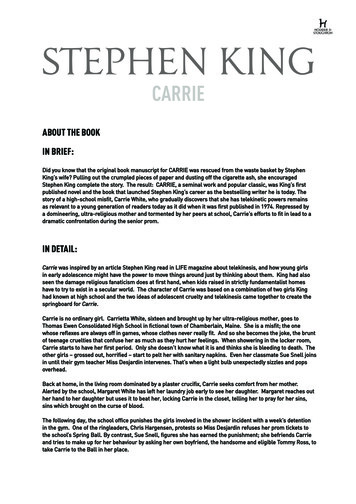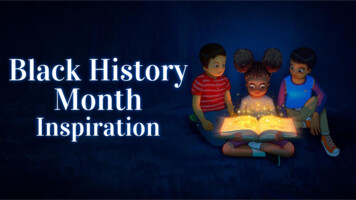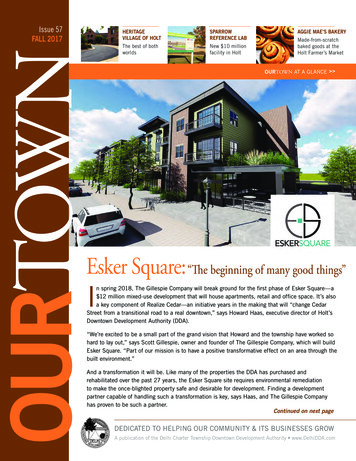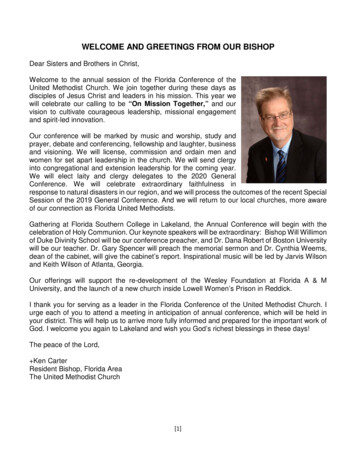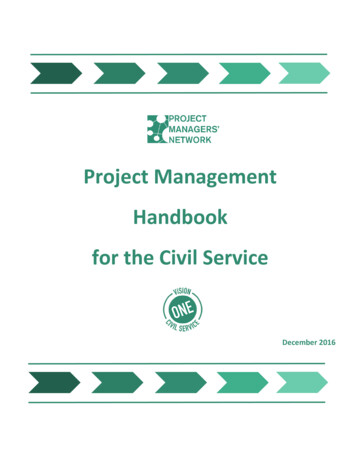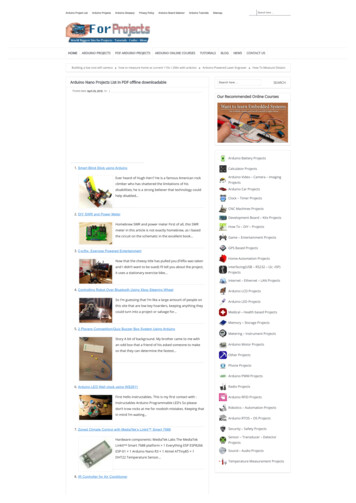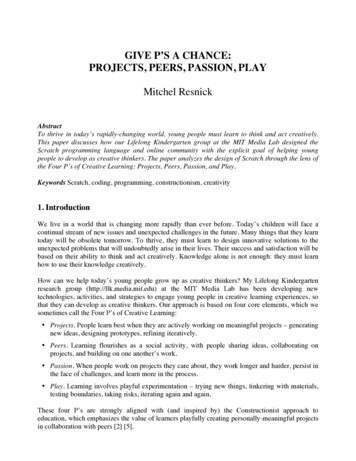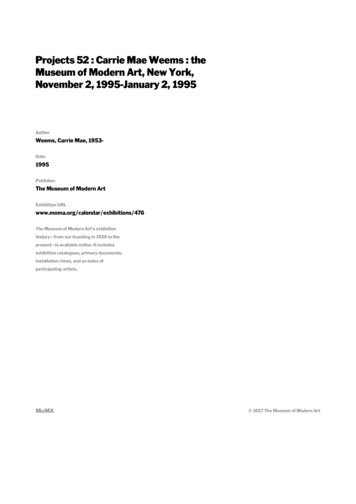
Transcription
Projects 52 : Carrie Mae Weems : theMuseum of Modern Art, New York,November 2, 1995-January 2, 1995AuthorWeems, Carrie Mae, 1953Date1995PublisherThe Museum of Modern ArtExhibition URLwww.moma.org/calendar/exhibitions/476The Museum of Modern Art's exhibitionhistory—from our founding in 1929 to thepresent—is available online. It includesexhibition catalogues, primary documents,installation views, and an index ofparticipating artists.MoMA 2017 The Museum of Modern Art
MiveMoMAWo carrie mae weemstn wuQ)0Q.TheNewMuseumofModernArtYorkNovember2. 1995—January2, 1996
2Toput it boldly, the new kind of critic and artist associatedwith the newcultural politics of difference consists of an energetic breed of NewV\/orld bricoleurs with improvisationai and flexible sensibilities thatsidestep mere opportunism and mindless eclecticism; persons fromall countries, cultures, genders, sexual orientations, ages and regionswith protean identities who avoid ethnic chauvinism and facelessuniversalism;intellectual and political freedom-fighters with partisanpassion, international perspectives,and, thank God, a senseof humorthat combats the ever-present absurdity that forever threatens ourdemocraticand libertarian projects and dampens the fire that fuels ourwill to struggle.Cornel West'A V heart Carrie Mae Weems is a storyteller. For nearly twodecades, she has been drawing upon personal and family histories aswell as African-American history and folklore in the creation ofpoetic ensembles of photographs and texts. Her work informs andentertains as it recounts tales infrequently or never before told. Itprovokes and challenges through the deadpan presentationof insidious stereotypes of race, gender, and class. In thrall to herskillful jokes and poignant stories, Weems's audience is led to criticalreflection upon the underlying social, political, and economicstructures out of which all particular stories are generated and to aheightened awareness of the role of various representationalpractices in reinforcing a dominant racist, sexist, and classistideologyand status quo here in the United States.The following conversation about the evolution of thisprojects installation is drawn from an interview with the artist onSeptember 15, 1995.Thomas W. Collins, Jr.Beaumont and Nancy Newhall Curatorial FellowDepartment of PhotographyThomas Collins: What general concerns drive your art making?Carrie Mae Weems: I want to make things that are beautiful,seductive, formally challenging, and culturally meaningful. Butsomehow, I also imagine that, within the confines of the art world, Iinsert a voice that is somewhat different. It's a voice that assumescultural fluidity. I'm also committed to radical social change— that'sthe reason that themes of social relations recur in my art practice. Ofcourse, the formal dimensions of how politics will play out in thework change over time, but the core of the work remains the same.Any form of human injustice moves me deeply— I mean, sends mestraight to the moon. So the battle against all forms of oppressionkeeps me going and keeps me focused. I'm a sucker for hope!TC: Critics infrequently do justice to this range of interests, mostoften treating only the way you handle questions about race.CMW: Unfortunately, many white critics assume that there existslittle in their social experience that provides them with the "means"to critique the work of black artists. Of course their art history M.A.'sdidn't provide them with much to draw from either. So they feel asthough they lack the grounds for providing a culturally informedcritique that goes beyond questions of race relations. Presumablyblacks as a social group operate within a closed system, andpresumably so does the art produced. And since blacks areconstructed as "the central problem" it's easier to talk about questions of race than to discuss the formal dimensions of black artisticproduction. Of course, it's important to know that ethnicity/gender
does play a role in how works of art are processedthrough the body ofthe artist, but the question is: what role?TC: The present installation is the result of a series of relatedexploratory journeys that you've taken in the last five years. In1991 you traveled to the Sea Islands off the coast of Georgiaand South Carolina, making photographs and generating textsresponsive to what you've called the "Africanisms," the language,customs, and material culture traceable directly to Africanprecedent, that persist in this isolated American communitydensely populatedwith the descendants of slaves from WestvoasAfrica. When you finished this body of work and the accompanying commemorative plate series Went Looking for Africa, youthen made your first trip to Africa.ofndCMW: After the Sea Islands series— a project that not only allowedme to think about art makingItanlerdifferently, but to make a differentkind of art — it was necessary forme to finally go to Africa. You:alticknow, West Africa, Senegal, isonly five and a half hours from)aNewlalgyshocked. Like everybody else, Ihad bought the idea that Africaliswas that distant and dark place,as far away as Timbuktu. ImpossibleanYork— digthat!I wasto get to!As I was flying over, I thoughtJr.about how it had been essential to the American political project toconstruct Africa as a distant and Godforsaken wasteland. It was a whypsychological distance based on America's need to distance itself fromits historical involvement in the slave trade, but further to absolve itselffrom any contemporary involvement, even though both Europe andAmerica have forced Africa's underdevelopment,ul,When I arrived, I immediately began photographing the vestigesutI, Iof slavery: the slave ports, forts, castles along the coast of Ghana,Elmina and Cape Coast, and lie de Goree in Senegal,esAs much as I like photographing people, the pictures are primarilyt'sOfarchitectural. For example in Went Looking For Africa, I was a subjectin search of myself and attempting to map a new psychological terrainieie.for myself and others. I suppose in the Sea Islands series and in thisinstallation, I'm trying to construct a new prism for looking at certainneinaspects of African-American culture and gender relationships— asJames Baldwin said, "searching for the evidence of things unseen." stunderstand material culture as the structure — the evidence— of myown world view.itsTC: This new work, though also inspired by your first stay in Africa,s".'smarks a departure from your examination of the institutionalization ofslavery and its legacies in both Africa and the United States. It doesBoth the Sea Islands series and this installation are about how I see andasparticipate, however, in this theme of search and discovery—?d)lysomething you make clear in the way you've wrapped the installationin a very particular decorative motif.idreCMW: The wallpaper comes from the endpapers of George BernardShaw's book, A Black Woman in Her Search for God [1933], I loved theisticermotif, and decided to use it as the ground that my photographs andtext would rest on. And besides, I was really getting tired of whitewalls. The wallpaper is a metaphor for the searching, probing, looking.
TC: This search led you to a reconsideration of myths of the creationof the first woman and the first man and their fall from grace. Howdid Africa as place and idea initiate this process?CMW: Life began in Africa. I concentrated on the look and feelof the place. But what was deep was the gender specificity of thearchitecture, particularly in Djenne, Mali. The idea that space is"gendered" — you know, male and female space— knocked meout. It was so clearly presented in the structure of the buildings —beautiful. In fact, this entire installation spins around severalbuildings I photographed in Djenne. Seeing these buildings andtrying to get a handle on their meaning were the raw materials forimagining and creating a visual/textual myth.TC: How, specifically, did the pieces involving architectural andlandscape photos and your original texts evolve?CMW: By simply letting the photographs tell me what I neededtodo with them. The text camemonths later. The pictures feelold, dusty, as though they weremade long ago— they are thestructure of my imagined world.But I wanted a text that felt evenolder—a text that would function asa myth, and it does,I hope.Myths are stories about thehistorical past that are believedto be true that tell us how thepresent world came to be. And as you know, human life began inAfrica, so in this installation I play with these ideas. But fortunately,I'm an artist, not an ethnographer, so I blend my own myth withthose from other cultures. Every culture has a creation myth andalmost all of them begin with the. battle between the first womanand man. I'm just playing it up in a different light.TC: In your retelling of this creation myth — and by "retelling" Imean the entire ensemble of photographs, texts and objects — youhighlight your own particular understanding of gender differenceand the dynamics of heterosexual relationships that necessarilyarisefrom this difference. Will you elaborate?CMW: Everything spins around this divide between men andwomen. The organization of the installation suggests that a unity, aresolve between them is essentially impossible. In fact, no resolve isthe only resolve. In the beginning a rupture occurred and that's that.What it leaves open, however, is the possibility for fashioning a newmodel for our relationships.TC: The screen The Apple of Adam's Eye, the first of these newpieces, is a focus of the installation. How do you think it announcesthese ideas?CMW: Even though there is a divide, there is also great desire,seduction, sexual charge and points to be made— you know, stuffthat makes the world go round. Both the text on the screen and onthe text panels play with creation myth. The image and text on thescreen challenge a number of assumptions about sexual desire,about religious belief, and about looking. It's an unsettling piece inmany ways.The installation is in some way about how both men andwomen are accomplicesin their own downfall, in their own oppression,
in their own victimization. It pushes against the way we live our lives,and asks the viewer to consider new models. You know, the oldones certainly aren't working.TC: Will you explain the ways in which both the pieces involvingphotographs of African sculpture and the actual sculptural objectsyou've included amplify and extend these themes?CMW: First, they're gorgeous. I love the song "Climbing theStairway to Heaven" by the O'Jay's; thus the ladders. The piecesloosely relate to the central idea of my project: after their battle, hesits with his tools of power and she with her generations — fertilitybeing her greatest gift.Also, these figures are symbolic representations of perfectionand future possibility. In certain African countries both men andwomen will carry this kind of figure with them throughout theiradult lives; the object signifies the perfect man or woman waitingfor them on the other side. These sculptures represent your perfectafterlife mate. So they're perfect in this context.TC: You've made clear that the dynamic you illustrate here isanchored in your own lived experience. How does your interpretation square with the socialist-feminist theory you've espoused?CMW: Of course, I'm a feminist, and I was involved with thesocialist-feminist movement. The work is certainly from a woman'sviewpoint, but has little to do with reactionary feminism — denialfeminism — you know, that kind of self-righteous, finger-pointing,"you did this to me" kind of feminism that hasn't figured out howwomen have been accomplices in their own victimization. It's muchmore interesting to think about how I participate in my own victimization. If I can figure that out, I can also start to figure out how toliberate myself from, as my girlfriend says, the "-ism brothers."1. "The New Cultural Politics of Difference," in Out There: Marginalization andContemporary Cultures, ed. Russell Ferguson, et al. (New York: New Museum ofContemporary Art; Cambridge, Mass.: MIT Press, 1990), p. 36.2. For examples of Weems's work produced 1978-92, see the exhibition catalogue CarrieMae Weems (Washington, D.C.: The National Museum of Women in the Arts, 1993). Forwork produced after 1993, see the exhibition catalogue Carrie Mae Weems (Philadelphia:The Fabric Workshop and Museum, 1995).biographyBorn Portland, Oregon, 1953B.F.A.,California Institute of the Arts, 1981M.F.A., University of California, San Diego, 1984M.A., Graduate Program in Folklore, University of California,Berkeley, ennial Exhibition, Seoul, KoreaFellow, The Mary Ingraham Bunting Institute,Radcliffe Researchand Study Center, Cambridge,MassachusettsThe Contemporary Arts Center, CincinnatiThe J. Paul Getty Museum, Malibu, CaliforniaInstitute of Contemporary Art, PhiladelphiaPortland Art Museum, Portland, OregonWalker Art Center, MinneapolisCalifornia Afro-American Museum, Los AngelesCenter for Fine Arts, MiamiThe Fabric Workshop and Museum, Philadelphia
A"3The Forum, St. LouisThe National Museum of Women in the Arts,Washington, D.C.1992San Francisco Museum of Modern ArtCleveland Center for Contemporary ArtGreenville County Museum, Greenville, South CarolinaLouis Comfort Tiffany AwardNexus Gallery, AtlantaP.P.O.W,New York CitySan Francisco Art Institute1991Art Complex Museum, Duxbury, MassachusettsFreedman Gallery Center for the Arts, Albright College,Reading, PennsylvaniaInstitute of Contemporary Art, BostonNew Museum of Contemporary Art, New York CityTrustman Gallery, Simmons College, BostonUniversity of Southern California, Irvine1990Wadsworth Atheneum, Hartford, ConnecticutCEPAGallery, BuffaloP.P.O.W,New York City198919871984Red Eye Gallery, Rhode Island School of Design, ProvidenceHampshire College Art Gallery, Amherst, MassachusettsAlternative Space Gallery, San DiegoMulti-Cultural Gallery, San DiegoSpecial thanks to Marion Boulton Stroud, Kelly Mitchell, Sue Patterson, and PamVanderzwan of The Fabric Workshop and Museum; Penny Pilkington, Wendy Olsoff, and ScottCatto of P.P.O.W,Inc.; and Paula Osagie.Front and back covers: The Apple of Adam's Eye. 1993. Pigment and silk embroidery oncotton sateen with Australian lacewood frame. 75 Va x 81 Vi x overall. (Text, front:"She'd always been the apple/Of Adam's eye." Text, back: "Temptation my ass, desire hasits place, and besides, they were both doomed from the start.") Photo: Will BrownInside: The Shape of Things. 1993. Gelatin-silver prints. 20 x 20" eachThe Apple of Adam's Eye courtesy The Fabric Workshop and Museum, Philadelphia. All otherwork courtesy the artist and P.P.O.W,Inc., New York.The projects series is made possible by generous grants from the Lannan Foundation, andThe Contemporary Arts Council and The Junior Associates of The Museum of Modern Art. 1995 The Museum of Modern Art, New YorkTheMuseumof Modern Art Library
A V heart Carrie Mae Weems is a storyteller. For nearly two decades, she has been drawing upon personal and family histories as well as African-American history and folklore in the creation of poetic ensembles of photographs and texts. Her work informs and entertains a
